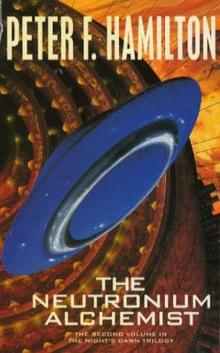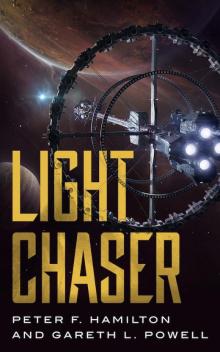- Home
- Peter F. Hamilton
Salvation
Salvation Read online
Salvation is a work of fiction. Names, characters, places, and incidents either are the products of the author’s imagination or are used fictitiously. Any resemblance to actual persons, living or dead, events, or locales is entirely coincidental.
Copyright © 2018 by Peter F. Hamilton
All rights reserved.
Published in the United States by Del Rey, an imprint of Random House, a division of Penguin Random House LLC, New York.
DEL REY and the HOUSE colophon are registered trademarks of Penguin Random House LLC.
Published in the United Kingdom by Pan, an imprint of Pan Macmillan, London.
LIBRARY OF CONGRESS CATALOGING-IN-PUBLICATION DATA
Names: Hamilton, Peter F., author.
Title: Salvation / Peter F. Hamilton.
Description: New York : Del Rey, [2018]
Identifiers: LCCN 2018009573 | ISBN 9780399178764 (hardcover : acid-free paper) | ISBN 9780399178771 (Ebook)
Subjects: | BISAC: FICTION / Science Fiction / Space Opera. | FICTION / Action & Adventure. | GSAFD: Science fiction.
Classification: LCC PR6058.A5536 S25 2018 | DDC 823/.914—dc23
LC record available at https://lccn.loc.gov/2018009573
Ebook ISBN 9780399178771
randomhousebooks.com
Book design by Jo Anne Metsch, adapted for ebook
Cover design and illustration: Anna Kochman, based on an image © agsandrew/Shutterstock
v5.3_r1.2
ep
Contents
Cover
Title Page
Copyright
Earth Calling
The Assessment Team
Juloss
The Assessment Team
Callum and Yuri
Juloss
The Assessment Team
Yuri’s Race Against Time
Juloss
The Assessment Team
The Case of Alik’s Favor
Juloss
The Assessment Team
The Death of Cancer
Juloss
The Assessment Team
Feriton Kayne’s Spy Mission
The Assessment Team
Juloss
The Assessment Team
Jio-Feriton Quint
Cast of Characters
Timeline
Dedication
By Peter F. Hamilton
About the Author
EARTH CALLING
Drifting through interstellar space, three light-years out from the star 31 Aquilae, the Neána abode cluster picked up a series of short, faint electromagnetic pulses that lasted intermittently for eighteen years. The early signatures were familiar to the Neána, and faintly worrying: nuclear fission detonations, followed seven years later by fusion explosions. The technological progress of whoever was detonating them was exceptionally swift by the usual metric of emerging civilizations.
Metaviral spawn chewed into the cometry chunks that anchored the vast cluster, spinning out a string of flimsy receiver webs twenty kilometers across. They aligned themselves on the G-class star fifty light-years away, where the savage weapons were being deployed.
Sure enough, a torrent of weak electromagnetic signals was pouring out from the star’s third planet. A sentient species was entering into its early scientific industrial state.
The Neána were concerned that so many nuclear weapons were being used. Clearly, the new species was disturbingly aggressive. Some of the cluster’s minds welcomed that.
Analysis of the radio signals, now becoming analogue audiovisual broadcasts, revealed a bipedal race organized along geo-tribal lines, and constantly in conflict. Their specific biochemical composition was one that, from the Neána perspective, gave them sadly short lives. That was posited as the probable reason behind their faster than usual technological progression.
That there would be an expedition was never in doubt; the Neána saw that as their duty no matter what kind of life evolved on distant worlds. The only question now concerned the level of assistance to be offered. Those who welcomed the new species’ aggressive qualities wanted to make the full spectrum of Neána technology available. They almost prevailed.
The spherical insertion ship that left the cluster—it didn’t know if it was one of many being dispatched, or alone—measured a hundred meters in diameter, a mass comprised of active molecule blocks. It spent three months accelerating up to thirty percent of light speed along a course to Altair—a trip that took just over a hundred years. During the lonely voyage the ship’s controlling sentience continued to monitor the electromagnetic signals coming from the young civilization that was its ultimate goal. It built up an impressive knowledge base of human biology, as well as a comprehensive understanding of their constantly evolving tribal political and economic structures.
When the ship reached Altair, it performed a complex flyby maneuver, which aligned it perfectly on Sol. After that, the physical section of the sentience’s memory that contained all the astrogation data of the flight from the cluster to Altair was jettisoned and the constituent blocks deactivated. Its weakened atomic structure broke apart into an expanding cloud of dust, which was quickly dispersed by Altair’s solar wind. Now, if it was ever intercepted, the insertion ship could never betray the position of the Neána abode cluster—for it no longer knew where it was.
The last fifty years of the voyage were spent formatting an emplacement strategy. By now, human ingenuity had produced starships that were flying past the insertion ship in the other direction, in quest of new worlds out among the stars. The information blasting out from Earth and the solar system’s asteroid habitats had become increasingly sophisticated, yet, conversely, there was a lot less of it. Radio signals had been in decline since the internet had begun to carry the bulk of human data traffic. For the final twenty years of the insertion ship’s approach it received little apart from entertainment broadcasts, and even those were shrinking year by year. But it had enough.
It flew in south of the ecliptic, shedding cold mass in irregular bursts like a black comet—a deceleration maneuver that took three years. This was always the riskiest part of the voyage. The humans’ solar system was scattered with a great many astronomical sensors scanning the universe for cosmological abnormalities. By the time it passed the Kuiper belt, the insertion ship was down to twenty-five meters in diameter. It emitted no magnetic or gravitational fields. The outer shell was fully radiation absorbent, so there was no albedo, making it invisible to any telescopes. Thermal emission was zero.
No one perceived its arrival.
Inside, four biologics began to grow within molecular initiators, attaining physical patterns the ship’s sentience had designed, based on the information it had acquired during the long voyage.
They were human in size and shape; skeletons and organs carried the mimicry down to a biochemical level. Their DNA was equally authentic. You would have to go a lot deeper into the cells to find any abnormality; only a detailed audit of the organelles would reveal alien molecular structures.
It was the minds of the biologics that gave the insertion ship the greatest difficulty. Human mental processes were complex verging on paradoxical. Worse, it suspected the performances in all the fictional dramas it received were overemphasizing emotional responses. So it constructed a stable primary architecture of thought routines, while including a fast learning and adaptive integration procedure.
As it closed to within a million kilometers of Earth, the
insertion ship discarded the last of its reaction mass as it performed a final deceleration maneuver. Now it was basically just falling toward the southernmost tip of South America. Tiny course correction ejecta refined the descent vector, steering it at Tierra del Fuego, which was still thirty minutes from greeting the dawn. Even if it was detected now, it would simply appear to be a small chunk of natural space debris.
It hit the upper atmosphere and began to peel apart into four pear-shaped segments. The remaining matter broke away in fizzing sparks that produced a short-lived but beautiful starburst display streaking through the mesosphere. Below it, sheltered under their blanket of thick winter cloud, the residents of Ushuaia, the southernmost city on Earth, remained oblivious of their interstellar visitor.
Each segment carried on down, aerobraking with increasing severity as the atmosphere thickened around them. They slowed to subsonic velocity three kilometers above the surface, plunging through the clouds, still unobserved by anyone on the planet.
The segments were aimed at a small inlet a few kilometers west of the city, where, even in AD 2162, the rugged land lay unclaimed by developers. Two hundred meters from the shore, four tall splash plumes shot up into the air like thick geysers, crowning and splattering down on the slushy ice that bobbed along the waters of the Beagle Channel.
The Neána metahumans floated to the surface. All that now remained of the insertion ship landing segments was a thick layer of active molecule blocks covering their skin like a pelt of translucent gel, insulating them from the dangerously cold water. They began to swim ashore.
The beach was a narrow strip of gray stones cluttered with dead branches. A dense woodland occupied the slope above it. The aliens scrambled a short way up the incline as the pale dawn light began to seep through the murky clouds. Their protective layer liquidized, draining down into the stones where it would be flushed away by the next high tide. For the first time, they drew air down into their lungs.
“Oh, that is cold!” one exclaimed.
“Good classification,” another agreed through chattering teeth. “I’ll go with it.”
They looked at one another in the gray light. Two were crying from the emotional impact of arrival, one was smiling in wonder, while the fourth appeared singularly unimpressed by the bleak landscape. Each carried a small pack of outdoor clothing copied from a winter wear ad broadcast eighteen months earlier. They hurried to put it on.
When they were fully dressed, they set off along an ancient track up through the trees until they came to the remnants of National Route Three, which led to Ushuaia.
THE ASSESSMENT TEAM
FERITON KAYNE, NEW YORK, JUNE 23, 2204
I was never really that impressed with New York. The natives always banged on about how it was the city that never sleeps, how it had elevated itself to the center of the human universe. Self-justifying their choice of living in cramped, overpriced apartments—even today, when they could live anywhere on the planet and commute in through a dozen different Connexion hubs. They claimed it still had the buzz, the vibe, the kick. Bohemians came to dose up on the experience, maaan that helped them create their art, while corporate drones sweated through their junior management years to prove commitment. But for service staff proximity was simply convenient, while the truly poor couldn’t afford to leave. And yes: Guilty, I lived in SoHo. Not that I’m junior management. Right there on my desk the nameplate says: Feriton Kayne, Deputy Director, Connexion Exosolar Security Division. And if you can work out what I actually do from that, you’re smarter than most.
My office was on the seventy-seventh floor of the Connexion Corp tower. Ainsley Zangari wanted his global headquarters in Manhattan, and did he ever want everyone to know about it. There are few other people alive who could get a site on West 59th Street just along from Columbus Circle. He had to keep the façade of the old hotel as the base of his 120-story glass-and-carbon monstrosity—why I don’t know; it had no architectural value as far as I can make out, but City Hall listed it as a landmark structure. So there you have it. Not even Ainsley Zangari, the richest man there’s ever been, can argue City Hall out of heritage.
I’m not complaining. My office gives me the greatest conceivable view out over the city and Central Park—one that the mere super-rich along Park Avenue can’t afford. I’ve actually had to position my desk so I work with my back to the floor-to-ceiling window. I’d be too distracted otherwise. Mind, it is a swivel chair.
That cloudless June afternoon I was standing looking out at the view, mesmerized as always; the vista resembled one of those seventeenth-century oil paintings where everything glows with heavenly radiance.
Kandara Martinez was shown in by a receptionist. The corporate mercenary wore a plain black singlet under a jacket from some midrange fashion house. The way she carried herself made it look like a military uniform. That part of her life just never left her, I guess.
Sandjay, my altme, splashed the data at me, which the tarsus lenses I wore over my eyeballs presented as a grid of green-and-purple text. The file didn’t tell me much I didn’t already know. She had enrolled in Mexico City’s Heroico Colegio Militar when she was nineteen. After graduation she saw several active deployments in the Urban Rapid Suppression Force. Then her parents were killed by a drone bomb some bunch of anti-imperialist anarchist whack-jobs launched at the sneering symbol of their evil foreign economic oppressors—or, in English, the Italian remote drone systems factory where her father worked. After that her escalating kill rate in action started to “concern” her superiors. She received an honorable discharge in 2187. Freelance corporate security ever since—the real dark jobs.
In the flesh she was 170 centimeters tall, with chestnut hair, cut short, and gray eyes. I wasn’t sure if they were real or gened-up; they didn’t quite seem to belong with the rest of her Mexican ancestry. There’d certainly been some bodywork. She kept herself trim—in her line of work that was survival 101—but that couldn’t account for the thickness of her limbs; her legs and arms were heavily muscled. Gened-up or Kcells; the file didn’t say. Ms. Martinez left a very small dataprint on solnet.
“Thank you for accepting the contract,” I said. “I’m a lot happier knowing you’re coming with us.” Which was only partially true. Her presence made me uncomfortable, but then I know whom she’s eliminated during her career.
“I was curious,” she said, “because we all know Connexion has so few people in its own security division.”
“Yeah, about that. We might need something that goes beyond our guys’ pay grade.”
“Sounds interesting, Feriton.”
“My boss wants protection, serious protection. We’re dealing with the unknown here. This expedition…it’s different. The artifact we’ve found is alien.”
“So you said. Is it Olyix?”
“I don’t see how it could be.”
A small smile lifted her lips. “Not going to hide from you, I’m very interested. And flattered. Why me?”
“Reputation,” I lied. “You’re the best.”
“Bullshit.”
“Seriously. We have to keep this small; the three other people coming with us represent some serious political interests. So I wanted someone with a genuine track record.”
“You’re worried that rivals will find out about where we’re headed? What sort of artifact have you found?”
“Can’t tell you that until we’re en route.”
“Are you retro engineering its tech? Is that why you’re worried about rivals?”
“This isn’t about new technology and market impact. We have a bigger problem than that.”
“Oh?” She lifted her eyebrow in query.
“You’ll get a full briefing when we’re underway. Everybody does.”
“Okay, that’s a reasonable containment strategy. But I do need to know: Is it hostile?”
“No. Or at least
, not yet. Which is where you come in. We need to pack a large punch in a small place. Just in case.”
“Even more flattered.”
“One last thing, which is why you and I are having this meeting before I introduce you to the rest of the team.”
“This doesn’t sound good.”
“There are some first-contact protocols involved, severe ones. Alpha Defense insisted. We’re going to be very isolated for the duration of this mission—something none of us are familiar with. Today, no matter what disaster hits you, everybody can shout for help wherever they are. Everyone functions under the assumption an emergency team is two minutes away. It’s all we know. I consider that to be a weakness, especially in this situation. If things go wrong—badly wrong—that’s when the Alpha Defense first-contact protocol applies.”
She caught on fast. I could see the slight change in body posture, humor retreating, muscles tightening.
“If they’re hostile, they can’t know about us,” she said.
“No prisoners. No data downloads.”
“Really?” Her humor swept back in. “You’re worried about an alien invasion? That’s very quaint. What does Ainsley Zangari think they’re going to plunder, our gold and our women?”
“We don’t know what they are, so until we do…”
“The Olyix turned out okay. And they had a shitload of antimatter on board the Salvation of Life. There isn’t another conventional power source powerful enough to accelerate a vessel that size up to a decent fraction of light speed.”
“We were fortunate with them,” I said carefully. “Their religion gives them a whole different set of priorities to us. All they want to do is travel across space in their arkship to the end of time, where they believe their God will be waiting for them. They don’t want to expand into new star systems and bioform planets to live on; it’s a whole different imperative to ours. I guess we didn’t really understand what alien meant until they arrived in the Sol system. But, Kandara, do you really want to gamble our species’ survival on every race being as benign as the Olyix? It’s been sixty years since they arrived, and we’ve both benefited from trade. Great, but we have a duty to consider that at some time we’re going to encounter a species that isn’t so benign.”

 A Night Without Stars
A Night Without Stars If at First . . .
If at First . . . The Neutronium Alchemist
The Neutronium Alchemist Great North Road
Great North Road Misspent Youth
Misspent Youth Pandora's Star
Pandora's Star The Evolutionary Void
The Evolutionary Void The Dreaming Void
The Dreaming Void Mindstar Rising
Mindstar Rising The Temporal Void
The Temporal Void A Quantum Murder
A Quantum Murder The Hunting of the Princes
The Hunting of the Princes Salvation Lost
Salvation Lost The Dreaming
The Dreaming Salvation
Salvation Light Chaser
Light Chaser The Mandel Files, Volume 2: The Nano Flower
The Mandel Files, Volume 2: The Nano Flower![The Saints of Salvation [British Ed.] Read online](http://i1.bookreadfree.com/22/the_saints_of_salvation_british_ed__preview.jpg) The Saints of Salvation [British Ed.]
The Saints of Salvation [British Ed.] Manhattan in Reverse
Manhattan in Reverse The Secret Throne
The Secret Throne A Window Into Time
A Window Into Time A Second Chance at Eden
A Second Chance at Eden The Nano Flower
The Nano Flower The Confederation Handbook
The Confederation Handbook The Naked God
The Naked God The Saints of Salvation
The Saints of Salvation The Void Trilogy 3-Book Bundle
The Void Trilogy 3-Book Bundle The Abyss Beyond Dreams
The Abyss Beyond Dreams A Voyage Through Air
A Voyage Through Air Judas Unchained
Judas Unchained The Commonwealth Saga 2-Book Bundle
The Commonwealth Saga 2-Book Bundle The Naked God - Flight nd-5
The Naked God - Flight nd-5 Night Without Stars (Chronicle of the Fallers Book 2)
Night Without Stars (Chronicle of the Fallers Book 2) Neutronium Alchemist - Conflict nd-4
Neutronium Alchemist - Conflict nd-4 Reality Dysfunction - Expansion nd-2
Reality Dysfunction - Expansion nd-2 Now We Are Ten: Celebrating the First Ten Years of NewCon Press
Now We Are Ten: Celebrating the First Ten Years of NewCon Press Neutronium Alchemist - Consolidation nd-3
Neutronium Alchemist - Consolidation nd-3 If at First . . . (Short Story)
If at First . . . (Short Story) A Second Chance at Eden nd-7
A Second Chance at Eden nd-7 Judas Unchained cs-2
Judas Unchained cs-2 The Mandel Files, Volume 1
The Mandel Files, Volume 1 Reality Dysfunction — Emergence nd-1
Reality Dysfunction — Emergence nd-1 The Temporal Void (ARC)
The Temporal Void (ARC) The Mandel Files
The Mandel Files Fallen Fragon
Fallen Fragon Misspent Youth (commonwealth saga)
Misspent Youth (commonwealth saga) If at First...
If at First... Best of British Science Fiction 2016
Best of British Science Fiction 2016 The Mandel Files, Volume 2
The Mandel Files, Volume 2 The Naked God - Faith nd-6
The Naked God - Faith nd-6 The Night's Dawn Trilogy
The Night's Dawn Trilogy Pandora's Star cs-2
Pandora's Star cs-2 A Window into Time (Novella)
A Window into Time (Novella)